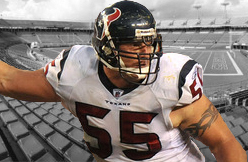At the core of the Houston Texans’ steady, methodical play this season in the face of a ridiculous injury list has been the offensive line.
Right tackle Eric Winston is a talker with a profile, but the rest of the group seems to revel in a degree of obscurity, no one more than center Chris Myers.
“I think he goes unnoticed for the kind of player he is,” Titans coach and Pro Football Hall of Fame offensive lineman Mike Munchak said. “He understands the system, understands what he’s supposed to do and he goes out and does it. It’s not about how big and tall he is or what his measurables are. He’s efficient, and he’s successful the way he does his job.”
Matt Williamson of Scouts Inc. says Myers is the second-best center in the NFL this season, behind only Nick Mangold of the Jets.
“Myers is a great technician,” Williamson said. “He’s got great movement skills. He plays the game with excellent leverage. He’s the linchpin of the best offensive line in the NFL.”
Myers was pleased to learn of Munchak’s compliment, but he clearly isn’t concerned with what people outside of team headquarters think of him, the line or the Texans.
In that regard, he’s an old-school offensive lineman. He trained under five-time Pro Bowler Tom Nalen in Denver and is perfectly happy operating quietly in the background, allowing his play to do most of his talking and pleased if his running back is getting attention.
“It just comes with the territory of being an offensive lineman,” he said. “When you get to the higher level, once you become successful in the league you learn those accolades will come when warranted.”
They should be warranted this season, with the Texans winning the AFC South despite a slew of injuries to key players.
Myers was originally a sixth-round pick by Denver in 2005, 200th overall out of Miami. He spent the first month of his first season on the practice squad, then backed up Nalen and played special teams.
The Texans traded a sixth-round pick in 2007 to get Myers after coach Gary Kubiak and general manager Rick Smith moved to Houston from jobs with the Broncos. Myers became a torch-bearer for both the sort of locker room culture and offensive line scheme the Texans wanted to establish. Houston has started him in every game.
There is less noise than there used to be about the Texans' zone-blocking scheme, a philosophy that features backside cuts that put defensive linemen on the ground. A lot of defenders hate it, and many say it puts their knees at risk. But it’s a legal technique that plenty of teams use, just not, perhaps, with the regularity and proficiency of the Texans.
It’s a scheme that serves to spring one-cut-and-go backs Arian Foster and Ben Tate, and syncs up perfectly with the Texans’ play-action and bootleg passing attack.
“You put them all together and they are pretty darn good at what they do,” Munchak said. “The five of them together, they’ve got it going. They’ve been doing the same thing now since [offensive line coach Alex] Gibbs went in there [in 2008]. They kept the same concept, they stuck with the same system and they’ve gotten good at it.”
There is a psychological aspect to the scheme as well.
“I can’t lie, it definitely plays into the defense’s mind,” Myers said. “When you’re pounding and pounding on guys throughout the game and you keep cutting them on the backside, they can play the cuts for a long time, but at a certain point either they are going to forget about it or get tired of having to play off of it. Once you kind of grind on them, it ends up playing out in the fourth quarter.”
Left tackle Duane Brown, left guard Wade Smith, Myers, right guard Mike Brisiel and Winston make up what has been one of the league’s best and most reliable lines this season. Brisiel just finished playing in the win at Cincinnati on a broken leg and had surgery, so Antoine Caldwell will step in for a stretch.
When the line and offense are playing well, the Texans’ attack can be a beautiful operation.
“So much about the way we run the ball is tied to coordination, there is a real rhythm to this offense,” Smith said.
“To the degree that you can get five guys and in a lot of cases six guys with the tight end and then seven with the fullback on the same page and execute that coordinated effort, that’s where you start to get the big runs and the cutbacks and you start to see the success in the system. They’ve got that coordination, they’ve got that rhythm together, and I think that’s why you see us running the ball effectively.”
As the Texans make their first venture into the playoffs, there will be talk of the line’s solid play, but far more focus on the league’s top defense, Foster, receiver Andre Johnson and rookie quarterback T.J. Yates.
Myers will have a great vantage point on it all, watching and working.
“Obviously his position is a natural position of leadership on the line,” Smith said. “He’s done a nice job of keeping our guys coordinated and he’s playing at a high level at this point.
“More often than not it’s a position where people don’t talk a lot, so maybe people don’t recognize how important or how strong a leadership position the offensive line commands within a team, but it’s significantly important. That’s where games are won and lost, up front.”

(espn.com)



